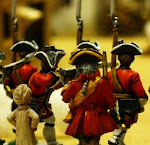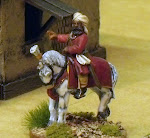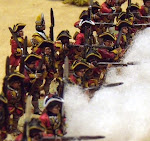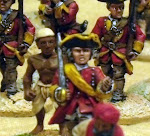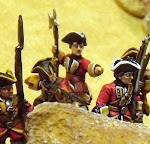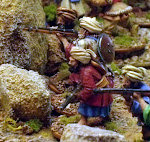On Saturday I had the chance to test out
Ambush Alley Games' Force on Force Modern Wargaming Rules. I have never had any real desire to do a modern conflict wargame, but Christian (from
... an inconvenience rightly considered) kindly asked if I'd be interested and I was more than happy to give it a go. Besides, Christian had a good selection of miniatures and between us both we already had a lot of appropriate terrain.
(Click the images to enlarge)
We got together at Christian's house and planned out the game. I was pretty much in the dark when it came to the rules and Christian had only played once,but I had heard very good things about FoF. We decided on an Asymmetric Engagement, that is some US soldiers Vs some Insurgents. Next came a fun part as we laid out the terrain and tried to make a good play area with some tactical choices. Christian provided the 2' by 2' board which was very nicely done. I was so surprised that the game worked in such a small area, considering our Indostan games are played on a 4' by 6' table, but I didn't really notice the tight confinement. Our table ended up looking like this:-
 |
| Table setup with Entry Zone and Hot Spots. |
 |
| Another layout view. |
The red numbered dots are "Hot Spots", basically spawn points for the Insurgents and the US Army symbol represented the "Entry Zone" for the US Fireteam. We cobbled together a very basic story that went something like, "A US patrol has been ordered to check a small village for the enemy." Pretty original - well we thought so.
The modern figures Christian has are from
Eureka Miniatures and they are all very nice figures, full of details and character. He managed to convert one US soldier into a Medic and has done some basic head-swaps on the Insurgents. Unfortunately they aren't painted yet, but as this was a trial game that really didn't bother us (well much...). He would play the single US Fireteam and I'd have a go with the Insurgents. Christian quickly detailed the two forces by writing their stats down, with the US soldiers being a Troop Quality of D8 and the Insurgents D6.
 |
| The US Fireteam entering the village. |
 |
| A slightly different angle and a peek at the heavily laden Medic conversion in the rear. |
An Asymmetric Operation will generally be Insurgent heavy and at this time we could only field about 15 figures, so we decided to tone down the Hot Spot table that generated the random forces. For some unknown reason we gave the Insurgents the first Initiative, but I believe I have since read that Irregular forces never have the Initiative.We pretty much blindly launched into the game from here and rolled for some Insurgents. In hind sight there probably should have been some already present somewhere on the board.
 |
| Two Insurgents appear on the building to West. |
The Hot Spot table produced two Insurgent from "HS1" and I chose to keep them hidden, which meant little as the US soldiers quickly spotted them. Another roll on the Hot Spot table produced a substantial force that appeared where I wanted them to - in the large building to the North, directly in front of the US Fireteam.
 |
| An Insurgent leader and his henchmen appear - one has a SAW - Yeah!! |
Dicing for the Initiative, I managed to win again and this is where all hell broke loose. We quickly found out that FoF is a game of "Reacting" to the actions of the other player and this process can get a little confusing. The US team manged to avoid being shot by either Insurgent group and made its way into the cover of the nearby low wall.
 |
| The Insurgents open fire on the US Fireteam. |
 |
| The Americans move into the cover of the low wall. |
|
|
|
I did not manage to field any more reinforcements for quite some time after that, we having ruled that there was a 50% chance more would show up each turn, which did prove problematic for the Insurgents. I did keep managing to win most Initiatives and I poured fire on the enemy. The Yanks managed to easily hold their own against this paltry force, and even when one of the Fireteam was wounded, Christian rolled a 6 on the First Aid Check and the wound proved totally superficial. The Insurgents on the other hand were outmatched and a number were seriously wounded. Ranged combat did flow quite well after a while and most of the simple modifiers were easily remembered, being a reduction or addition of whole dice, rather than pluses or minuses to die results.
Eventually I did roll more Insurgents which appeared at "HS1" again, adjacent to the US team. I had them pop out into the street to the North of "HS1", which promptly saw them mowed down by the Americans at optimal range. They were not all killed outright and some did manage to open fire on the enemy, but were ineffective even at this close range.
 |
| More Insurgents arrive, only to be mowed down by the Americans. |
 |
| Even this close the Insurgents can't wound the Americans. |
We next tried an example of a Close Assault that did not end well for the two Insurgents involved. They leaped the low wall screaming for blood and promptly got shot to pieces, leaving the Americans an opportunity to try and capture "HS1". Two of them climbed the ladder to the roof in an attempt to hunt down the remaining wounded Insurgents up there. They managed to kill the enemy, but did take a wound in the process. As luck would have it Christian rolled another 6 and the US soldier got straight back up, unharmed. We unfortunately had to call it quits at this stage, but with little in the way of a scenario the game could have gone on all night.
 |
| A Close Assault ends poorly for the Insurgents. |
 |
| The last Insurgent at "HS1" is killed and a US soldier is brought down. |
All in all I had a really good time and thoroughly enjoyed my FoF experience. We were both definitely under prepared when it came to knowing the rules and a great portion of the game was spent frantically shuffling through pages in an attempt to find the rule we were after. I can see the game flowing much more easier when we master Initiative and the Reaction orders, which make up a large part of the complexity of the rules. I look forward to another game soon and writing a less "static and technical" AAR.















